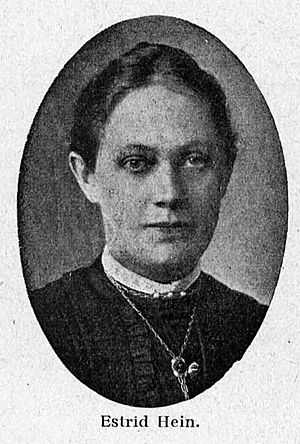Estrid Hein facts for kids
Estrid Hein (born Estrid Hansen; July 27, 1873 – July 25, 1956) was a Danish eye doctor, a champion for women's rights, and a supporter of peace. She worked in Copenhagen starting in 1898. In 1906, she opened her own eye clinic. Estrid was also a key person in the women's movement. She led the Copenhagen group of the Danish Women's Society from 1909. Later, she joined the main board of the society. In 1915, she became an active member of Danske Kvinders Fredskæde. This was the Danish part of the Women's International League for Peace and Freedom. That same year, she joined a group working on family laws in Scandinavia. Here, she helped improve rights for women as spouses. From 1933, she was on the executive board of Denmark's Women's Council.
Early Life and Education
Estrid Hansen was born in Copenhagen on July 27, 1873. Her father, Octavius Thomas Hansen, was a politician. Her mother, Ida Antoinette Wulff, was known for her needlework. Estrid grew up in a comfortable home. She met many important political and cultural people when she was a child.
After finishing school at N. Zahle's School in 1890, she studied medicine. She went to the University of Copenhagen and graduated in 1896. In September of that year, she married Hjalmar Hein, an engineer. She then spent a year in Paris studying how eyes work. After that, she traveled to clinics in Britain, the Netherlands, Austria, and Germany to learn more.
Professional Life and Activism
When Estrid Hein returned to Copenhagen, she started working as an eye doctor in 1898. In 1906, she opened her own clinic. Many people liked her work, and she had many happy patients. She received her special certificate in eye care in 1918. She continued to practice until she retired in 1939.
Hein was also very active in the women's movement. She became a medical expert for the Women's Trades and Office Workers Association. She also served on the board of the Louise Society. This group helped single women who were struggling. In 1914, she became the first woman to join the board of the Blind Institute.
From 1909 to 1916, Hein led the Copenhagen branch of the Danish Women's Society. She was one of the most liked people in the group. She worked hard to get equal rights for women. This included voting rights and fair factory laws. In 1915, she became an early member of Danske Kvinders Fredskæde. This was the Danish part of the Women's International League for Peace and Freedom. She joined with Thora Daugaard, Clara Tybjerg, Benny Cederfeld de Simonsen, and Henni Forchhammer.
That same year, she joined the Scandinavian Family Law Commission. This group successfully worked to improve women's rights in marriage. Their efforts led to important marriage reforms in Denmark in 1920.
Hein also worked with a Danish committee to fight against the exploitation of women and children. She played a big role in the League of Nations' Advisory Committee. This committee worked to stop the trafficking of women and children. She was a delegate for 18 years. From 1933, she was a board member of the National Women's Council.
Estrid Hein passed away in Hørsholm on July 25, 1956.


